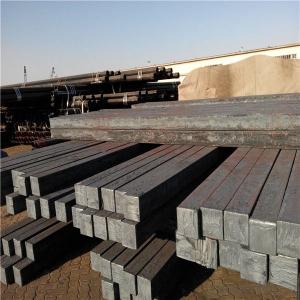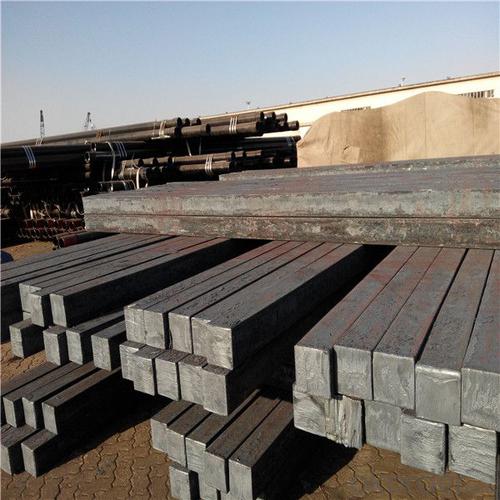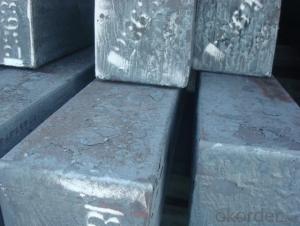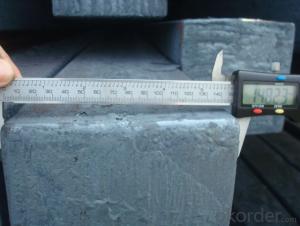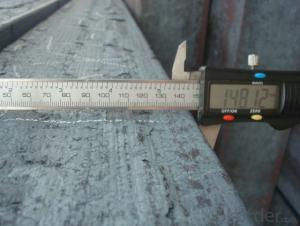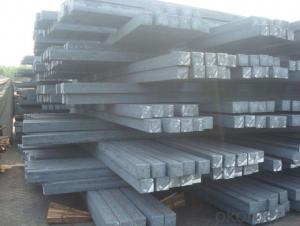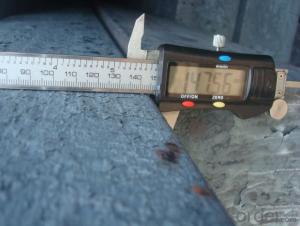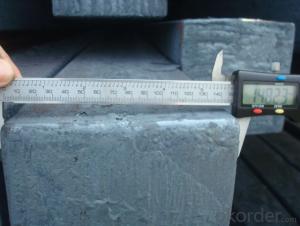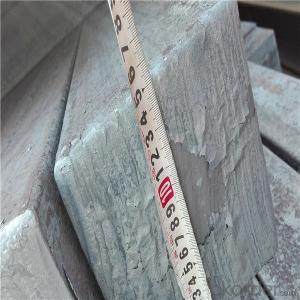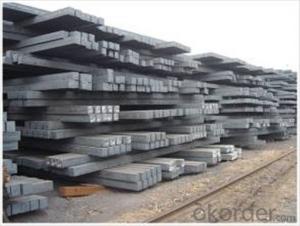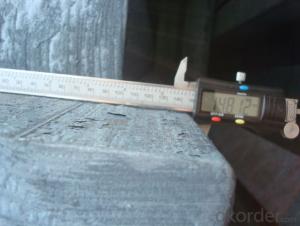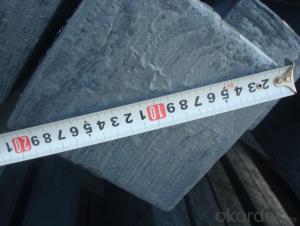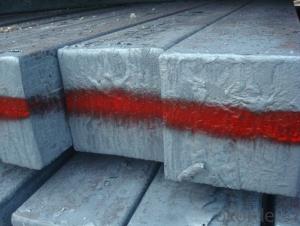Square Steel Billets hot sale Q275 grade
- Loading Port:
- Tianjin
- Payment Terms:
- TT OR LC
- Min Order Qty:
- 1000 m.t.
- Supply Capability:
- 15000 m.t./month
OKorder Service Pledge
OKorder Financial Service
You Might Also Like
Specification
Steel billet
(ingot) by cogging or breakdown of semifinished products, is the raw material of all kinds of steel mill.
Billet section of square, round, flat, rectangular and abnormity of several kinds of, mainly related to the
shape of rolled products.
Rectangular billet continuous casting billet and mainly general carbon steel, low carbon low silicon cold-rolled material, high quality carbon structural steel, high strength low alloy steel, special steel, etc.
The billet is mainly divided into two kinds from the shape:
Slab: cross section width and height of the ratio of the larger, mainly used for rolling plate.
Gade:
Standard | C(%) | Mn(%) | S(%) | P(%) | Si(%) |
Q195 | ≤0.12 | ≤0.50 | ≤0.040 | ≤0.035 | ≤0.30 |
Q235 | ≤0.20 | ≤1.40 | ≤0.045 | ≤0.045 | ≤0.35 |
Q275 | ≤0.22 | ≤1.50 | ≤0.045 | ≤0.045 | ≤0.35 |
20MnSi | 0.17-0.25 | 1.2-1.6 | ≤ 0.050 | ≤ 0.050 | 0.40-0.80 |
3SP | 0.14-0.22 | 0.40-0.85 | ≤ 0.050 | ≤ 0.040 | 0.05-0.15 |
5SP | 0.28-0.37 | 0.50-1.00 | ≤ 0.050 | ≤ 0.040 | 0.15-0.30 |
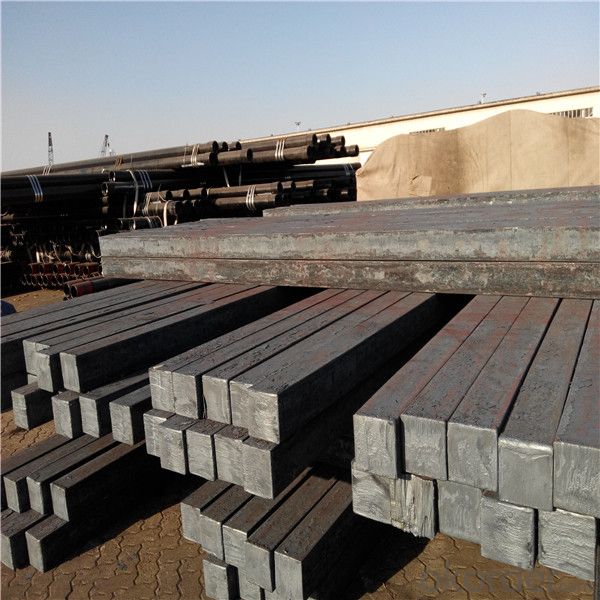
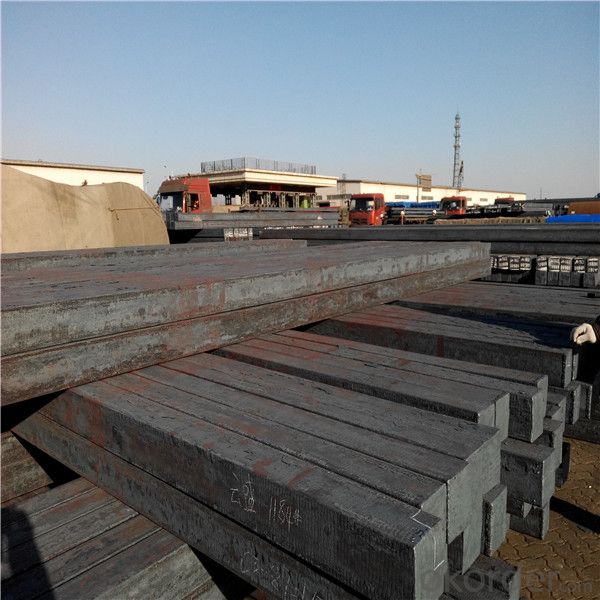
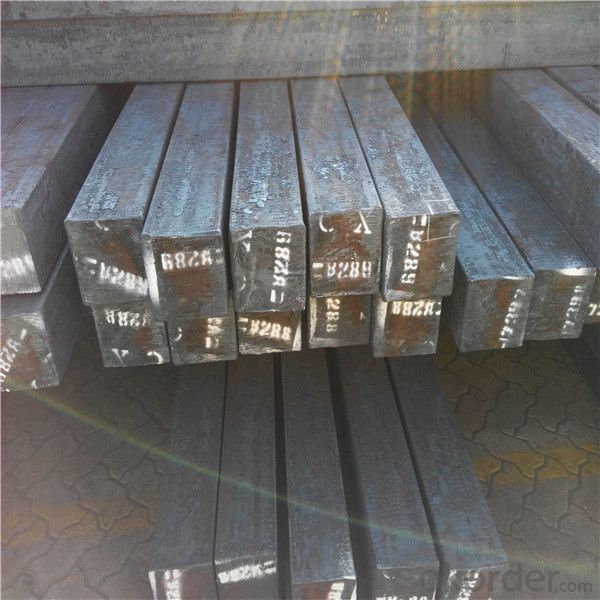
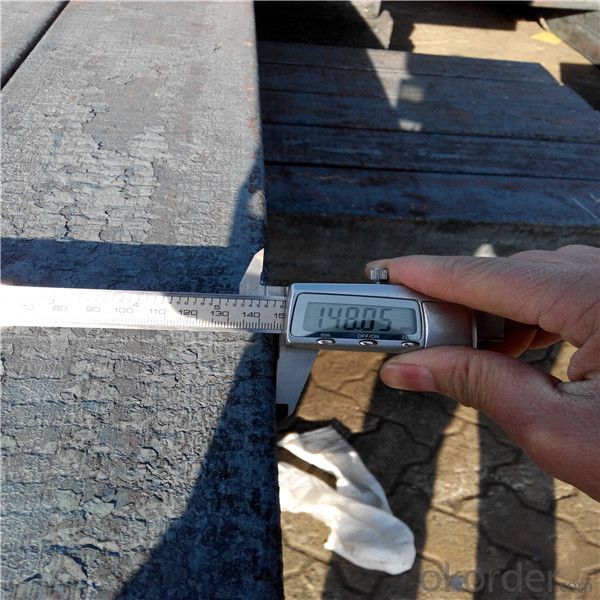
Our service :
We have a plant and professional team to provide our best service, from the start of production until the
loading into the vessel, we have a complete quality follow up procedure, to assure our products arrives to the customer with satisfaction. Welcome new and old customers
to contact us for future business relationships! We will give you a surpise price.
Packing :
Within 30 days
1.Standard export package
2.In bundles with steel strips
3.As the requirements of the customers
FAQ:
Q: What is payment terms?
A: FOB 30% T/T IN ADVANCE AS DEPOSIT AND 70% T/T BEFORE SHIPMENT
CIF and CFR 30% T/T IN ADVANCE AS DEPOSIT AND 70% T/T AS THE COPY OF B/L OR L/C AT SIGHT
Q:How to guarantee the quality of the products?
A:We have established the international advanced quality management system,every link from raw material
to final product we have strict quality test;We resolutely put an end to unqualified products flowing into the market.
At the same time, we will provide necessary follow-up service assurance.
Q:How long can we receive the product after purchase?
A :In the purchase of product within three working days, We will arrange the factory delivery as soon as possible.
The pecific time of receiving is related to the state and position of customers.
- Q: What are the main factors affecting the machined surface quality of steel billets?
- The machined surface quality of steel billets is significantly influenced by various main factors. These factors encompass the following: 1. Cutting Speed: The speed at which the tool traverses the billet's surface plays a vital role in determining the surface quality. Higher cutting speeds can generate excessive heat, resulting in thermal damage and subpar quality. Hence, it is crucial to identify the optimal cutting speed to attain a high-quality machined surface. 2. Feed Rate: The rate at which the tool advances into the material during machining is referred to as the feed rate. A high feed rate can cause excessive tool wear, leading to poor surface quality. Conversely, a low feed rate may induce chatter or vibration, causing surface irregularities. Striking the right balance is essential to achieve a smooth and high-quality machined surface. 3. Tool Geometry: The shape, angle, and edge sharpness of the cutting tool significantly impact the surface quality. Tool geometry affects chip formation and the interaction between the tool and the billet. Proper tool geometry can minimize cutting forces, vibration, and improve chip evacuation, resulting in an enhanced surface finish. 4. Cutting Fluid: The choice and application of cutting fluids exert a substantial influence on the surface quality of machined steel billets. Cutting fluids serve multiple purposes, such as cooling the tool and workpiece, lubricating the cutting process, and removing chips. Appropriate selection and application of cutting fluids can reduce friction, heat generation, and tool wear, thereby enhancing surface quality. 5. Billet Material and Hardness: The material composition and hardness of the steel billet also affect the machined surface quality. Different steels exhibit varying levels of machinability, with some being more susceptible to issues like work hardening or built-up edge formation. Harder materials generally necessitate robust cutting tools and specific machining techniques to achieve the desired surface quality. 6. Machine Rigidity and Stability: The rigidity and stability of the machine employed for machining steel billets are crucial factors influencing surface quality. Any deflection or vibration in the machine tool can result in subpar surface finish and dimensional accuracy. Therefore, ensuring proper machine setup, alignment, and maintenance is essential to minimize unwanted vibrations and maximize surface quality. In summary, a combination of the aforementioned factors, along with appropriate cutting parameters and machining techniques, is indispensable for achieving a high-quality machined surface on steel billets. Adjusting these factors based on the billet's specific characteristics and desired surface finish can optimize the machining process and enhance the overall quality of the final product.
- Q: What are the main factors affecting the machinability of stainless steel billets?
- The main factors affecting the machinability of stainless steel billets include the composition and microstructure of the steel, the hardness and work hardening characteristics, the cutting tool material and geometry, the cutting parameters such as cutting speed, feed rate, and depth of cut, and the cooling and lubrication methods used during machining.
- Q: How do steel billets contribute to the overall recyclability of a product?
- The overall recyclability of a product is significantly improved with the use of steel billets. These semi-finished steel products are formed through the process of casting, where molten steel is poured into molds and allowed to solidify. To begin with, steel billets possess the remarkable ability to be melted down and reprocessed multiple times without compromising their structural integrity or quality. This characteristic renders steel billets highly recyclable and ideal for utilization as raw materials in the production of various steel products. When a steel product reaches the end of its lifespan, it can be melted down and transformed into new steel billets for further usage. Moreover, steel billets contribute to the circular economy by reducing the necessity for primary steel production. By recycling and reusing steel, the demand for extracting raw materials and consuming excessive energy during the manufacturing process is minimized. This conservation of natural resources not only diminishes greenhouse gas emissions but also mitigates the overall environmental impact associated with steel production. Additionally, steel billets enable the creation of products with a greater proportion of recycled content. By incorporating recycled steel into new products, the overall recyclability of the final product is heightened. This not only conserves energy and resources but also diminishes the amount of waste that would otherwise find its way into landfills. In conclusion, steel billets enhance the recyclability of a product by virtue of their own high recyclability, reduction in the demand for primary steel production, and augmentation of the recycled content in the final product. Their contribution to the circular economy and environmental sustainability makes them an indispensable component in the overall life cycle of steel products.
- Q: What are the different types of cleaning methods used for steel billets?
- There are several different types of cleaning methods used for steel billets. These include mechanical cleaning methods such as shot blasting or wire brushing, chemical cleaning methods like pickling or acid cleaning, and thermal cleaning methods such as annealing or heat treatment. Each method is chosen based on the specific requirements and condition of the steel billets to ensure effective and efficient cleaning.
- Q: What are the different methods of steel billet surface etching?
- Various industries commonly use several different methods for steel billet surface etching. These methods encompass chemical etching, electrolytic etching, and laser etching. 1. Chemical etching involves the immersion of the steel billet in a chemical solution, typically an acid, that selectively eliminates a thin layer of material from the surface. The specific chemical solution utilized depends on the etching process requirements, such as desired depth and pattern. Hydrochloric acid, nitric acid, and ferric chloride are commonly employed chemicals for steel etching. 2. Electrolytic etching entails passing an electric current through the steel billet while it is submerged in an electrolyte solution. The current facilitates a controlled dissolution of the surface metal, resulting in the desired etched pattern. Electrolytic etching provides precise control over the process and can generate intricate and detailed designs. It is often employed for marking or labeling steel billets with logos, serial numbers, or other identification marks. 3. Laser etching is a highly precise and non-contact method of surface etching. It involves the use of a laser beam to selectively remove material from the steel billet surface. Computer software directs and controls the laser beam, enabling intricate and customizable designs. Laser etching is suitable for creating permanent markings, logos, or patterns on steel billets. It finds wide application in industries such as automotive, aerospace, and electronics. Each method has its own advantages and limitations, and the choice of etching method depends on factors like the desired design, the material properties of the steel billet, and the production requirements.
- Q: How do steel billets contribute to the overall fire resistance of a structure?
- The overall fire resistance of a structure is enhanced by steel billets in several ways. Firstly, steel billets are made of a non-combustible material, meaning they cannot burn or aid in the spread of fire. By incorporating steel billets into a building's construction, the risk of fire propagation is significantly reduced. Secondly, steel possesses a high melting point, typically around 1370 degrees Celsius. This characteristic enables steel to maintain its structural integrity and resist deformation even under intense heat. By using solid steel blocks, known as steel billets, the structure gains strength and stability that can withstand the impact of a fire. Moreover, steel exhibits low thermal conductivity, resulting in poor heat conduction. This property helps to slow down the transfer of heat from the fire to the surrounding areas of the structure. By acting as a barrier, steel billets hinder rapid temperature rise, allowing occupants more time to evacuate and firefighters more time to extinguish the fire. Furthermore, steel billets are frequently utilized in constructing fire-resistant walls or barriers within a structure. These walls are designed to compartmentalize the building, confining the spread of fire and smoke to specific areas. By incorporating steel billets into these fire-resistant walls, the overall construction becomes more durable and capable of enduring the extreme conditions of a fire. In conclusion, steel billets play a crucial role in enhancing the overall fire resistance of a structure due to their non-combustible nature, high melting point, low thermal conductivity, and ability to reinforce fire-resistant walls. By incorporating steel billets into the construction process, buildings can achieve greater resilience against fire incidents, ensuring the safety of occupants and minimizing fire damage.
- Q: How are steel billets used in the manufacturing of valves and pumps?
- Valves and pumps require steel billets, which are necessary raw materials in their manufacturing process. These billets are cast into specific shapes, typically squares or rectangles, and serve as the foundation for producing valves and pumps. To make valves, steel billets are first heated and then forged or rolled into the desired shape. The billets undergo various processes like cutting, drilling, and machining to create different valve components, including the body, bonnet, disc, stem, and seat. These components are then assembled to form the valve, which controls the flow of fluids or gases in a system. Similarly, in pump manufacturing, steel billets are heated and shaped to create essential parts such as impellers, casings, shafts, and housings. These parts are then assembled to construct a pump, responsible for transferring fluids or gases from one location to another. The use of steel billets in valve and pump manufacturing is crucial due to steel's inherent properties. Steel is highly valued for its strength, durability, and resistance to corrosion, making it ideal for applications in industries where valves and pumps face high pressures, temperatures, and corrosive environments. Moreover, steel's versatility allows manufacturers to customize valves and pumps in terms of size, shape, and specifications to meet the specific requirements of diverse industries and applications. This adaptability ensures that valves and pumps made from steel billets can perform reliably and efficiently in various environments and conditions. In conclusion, steel billets play a vital role in the manufacturing of valves and pumps. Through forging, shaping, and assembly processes, steel billets are transformed into essential components that constitute these crucial industrial devices. The use of steel guarantees the strength, durability, and corrosion resistance needed for valves and pumps to function effectively and endure demanding operational conditions.
- Q: What are the different surface treatments applied to steel billets?
- There are several surface treatments that can be applied to steel billets. Some common treatments include hot-dip galvanizing, electroplating, powder coating, and painting. These treatments help to protect the steel from corrosion, improve its appearance, and enhance its durability. Additionally, surface treatments can also be used to provide specific characteristics such as increased hardness or improved resistance to wear and tear.
- Q: What are the potential applications of steel billets in the aerospace aftermarket?
- Steel billets have a wide range of potential applications in the aerospace aftermarket. These applications include but are not limited to the production of various aerospace components such as engine parts, airframe structures, landing gear components, and fasteners. One potential application of steel billets in the aerospace aftermarket is the manufacturing of engine parts. Steel billets can be used to produce critical components such as turbine blades, compressor discs, and shafts. These parts require high strength, durability, and resistance to extreme temperatures, all of which can be achieved through the use of steel billets. Additionally, steel billets can be used to produce exhaust system components, such as manifolds and flanges, which also require high temperature resistance. Another important application of steel billets in the aerospace aftermarket is in the production of airframe structures. Steel billets can be utilized to manufacture various structural components, including beams, frames, and brackets. These components are crucial for providing strength and stability to the aircraft's fuselage, wings, and other structural elements. Steel billets offer the necessary strength-to-weight ratio, corrosion resistance, and fatigue resistance required for these demanding applications. Furthermore, steel billets can be used to produce landing gear components in the aerospace aftermarket. Landing gear plays a critical role in the safe operation of an aircraft, and it must withstand significant loads and stresses during takeoff, landing, and taxiing. Steel billets can be machined into landing gear parts such as axles, struts, and wheels, which require high strength, toughness, and fatigue resistance. Lastly, steel billets find applications in the production of fasteners used in the aerospace aftermarket. Fasteners such as bolts, screws, and nuts are essential for joining various components together in an aircraft. Steel billets can be forged or machined into high-strength fasteners that can withstand the high loads and vibrations experienced during flight. In summary, steel billets have numerous potential applications in the aerospace aftermarket. From engine parts to airframe structures, landing gear components, and fasteners, steel billets provide the necessary properties required for the demanding aerospace industry, including strength, durability, temperature resistance, and fatigue resistance.
- Q: How do steel billets contribute to the overall aesthetics of a product?
- Steel billets do not directly contribute to the overall aesthetics of a product as they are semi-finished products in the steel manufacturing process. However, they play a crucial role in determining the structural integrity and quality of the final product, which indirectly impacts its overall aesthetics.
Send your message to us
Square Steel Billets hot sale Q275 grade
- Loading Port:
- Tianjin
- Payment Terms:
- TT OR LC
- Min Order Qty:
- 1000 m.t.
- Supply Capability:
- 15000 m.t./month
OKorder Service Pledge
OKorder Financial Service
Similar products
Hot products
Hot Searches
Related keywords
